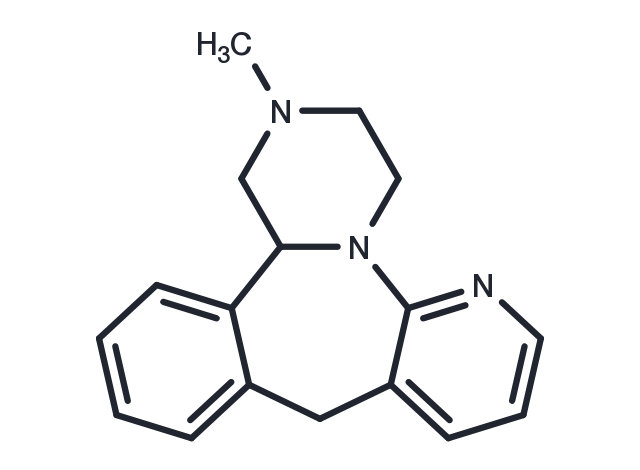Powder: -20°C for 3 years | In solvent: -80°C for 1 year


Mirtazapine (6-Azamianserin) is a tetracyclic antidepressant with a somewhat unique mechanism of action. Mirtazapine therapy can be associated with transient asymptomatic elevations in serum aminotransferase levels and has been linked to rare instances of clinically apparent acute liver injury.

| Pack Size | Availability | Price/USD | Quantity |
|---|---|---|---|
| 5 mg | In stock | $ 34.00 | |
| 10 mg | In stock | $ 46.00 | |
| 25 mg | In stock | $ 73.00 | |
| 50 mg | In stock | $ 98.00 | |
| 100 mg | In stock | $ 156.00 | |
| 200 mg | In stock | $ 265.00 | |
| 500 mg | In stock | $ 473.00 | |
| 1 mL * 10 mM (in DMSO) | In stock | $ 86.00 |



| Description | Mirtazapine (6-Azamianserin) is a tetracyclic antidepressant with a somewhat unique mechanism of action. Mirtazapine therapy can be associated with transient asymptomatic elevations in serum aminotransferase levels and has been linked to rare instances of clinically apparent acute liver injury. |
| In vitro | Mirtazapine displays marked affinity for cloned, human alpha2A-adrenergic (AR) receptors at which it blocks noradrenaline (NA)-induced stimulation of guanosine-5'-O-(3-[35S]thio)-triphosphate ([35S]-GTPgammaS) binding. Mirtazapine shows high affinity for cloned, human serotonin (5-HT)2C receptors at which it abolishes 5-HT-induced phosphoinositide generation. Mirtazapine markedly elevates dialysate levels of NA and, in FCX, DA, whereas 5-HT is not affected.[1] Mirtazapine enhances the effectiveness of the electrical stimulation of the ascending 5-HT pathway by blocking both alpha-2 adrenergic auto- and heteroreceptors. Mirtazapine blocks the suppressant effect of microiontophoretically applied norepinephrine (NE) on the firing activity of CA3 dorsal hippocampus pyramidal neurons, indicating their antagonistic effects on postsynaptic alpha-2 adrenoceptors. [2] |
| In vivo | Mirtazapine (10-250 mg/kg i.v.) enhances dose-dependently the firing activity of the 5-HT neurons in naive rats, but not in 6-hydroxydopamine-pretreated rats. [2] Mirtazapine (5 mg/kg/day, s.c., using osmotic minipumps) increases the spontaneous firing activity of locus coeruleus noradrenaline (NA) neurons in male Sprague-Dawley rats. Mirtazapine antagonizes both the enhancing effect of a low dose (10 mg/kg, i.v.) and the reducing effect of a high dose (100 mg/kg, i.v.) of the alpha 2-adrenoceptor agonist clonidine on the effectiveness of the electrical stimulation of the ascending 5-HT pathway in suppressing the firing activity of dorsal hippocampus CA3 pyramidal neurons. [3] Mirtazapine (5 mg/kg s.c.) only slightly affects DOPAC and homovanillic acid levels in the striatum, hardly affects 5-HT release in freely moving rats, but clearly increased 5-hydroxyindole acetic acid. [4] |
| Synonyms | 6-Azamianserin, Org3770 |
| Molecular Weight | 265.35 |
| Formula | C17H19N3 |
| CAS No. | 85650-52-8 |
Powder: -20°C for 3 years | In solvent: -80°C for 1 year
Ethanol: 53 mg/mL (199.73 mM)
H2O: < 1 mg/mL (insoluble or slightly soluble)
DMSO: 53 mg/mL (199.73 mM)
You can also refer to dose conversion for different animals. More
bottom
Please see Inhibitor Handling Instructions for more frequently ask questions. Topics include: how to prepare stock solutions, how to store products, and cautions on cell-based assays & animal experiments, etc.
Mirtazapine 85650-52-8 Endocrinology/Hormones GPCR/G Protein Immunology/Inflammation Neuroscience 5-HT Receptor Opioid Receptor Dopamine Receptor Histamine Receptor Adrenergic Receptor 5-HT2 Inhibitor 5-HT3 α2-adrenoceptor inhibit oral serotonergic 5-hydroxytryptamine Receptor Antidepressant TNFα noradrenergic Org-3770 Beta Receptor 6-Azamianserin Org3770 Serotonin Receptor autoimmune Org 3770 inhibitor
